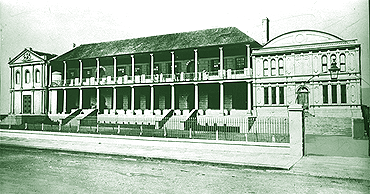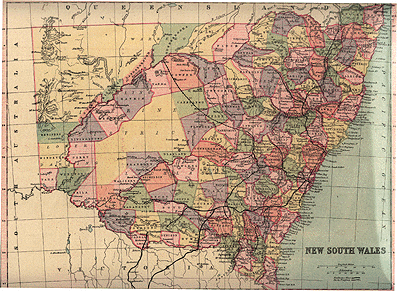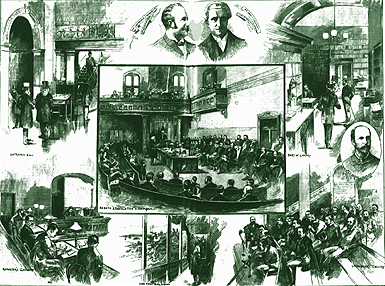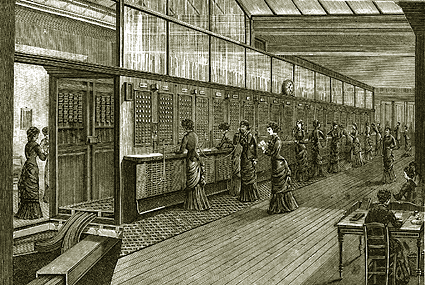A New Parliament, 1856
 New South Wales Parliament House, 1856, showing the new Legislative Council Chamber on the right.
New South Wales Parliament House, 1856, showing the new Legislative Council Chamber on the right.
The rounded roofline proved too hot and noisy and was soon covered by a more conventional gabled roof.
The new Parliament of New South Wales was a bicameral (two House) Legislature, similar to that of England, consisting of an Upper House (Legislative Council) and Lower House (Legislative Assembly). The new Legislative Council was to consist of no fewer than 21 Members nominated by the Governor on the advice of his Executive Council and initially appointed for 5 years and thereafter for life. There were no property qualifications for appointment, but Public Servants could not be appointed.
The new Legislative Assembly of 54 Members could consist of any men qualified and registered as voters, except for holders of office or pension under the Crown, public servants, active military officers and ministers of religion. Sixteen of the 34 electoral districts would return more than one Member. Voters had to be men over 21 who met a fairly modest property or income qualification. Voters who fulfilled the qualifications in more than one district could have multiple (plural) votes. The Governor retained significant powers.
Money bills had to originate in the Assembly, and amendments to the Constitution required two-thirds majorities in both Houses.
Although many significant changes have been made over time, the broad structure established in 1856 remains.
On 22 May 1856, the bicameral New South Wales Parliament opened and sat for the first time.
Both the Governor’s instructions and the New South Wales Constitution Act required the continuing existence of the Executive Council, but there were no formal requirements that its Members should be the Ministers of Departments. Ministers did not even have to be Members of the Parliament. Under Westminster convention, however, Executive Councillors were both Members of the Parliament and Ministers of the Crown, thus forging a bridge between the Parliament and the Executive. This convention was followed in New South Wales.
There were five “official” Members, or Ministers, in the Legislative Assembly. These, with the Governor, made up the official body, the Executive Council. The Council’s role was to advise the Governor in carrying out his functions in the administration of the State.
The Public Service
The executive arm of government operates through the Public Service, the government departments and bodies which implement and administer policy. The Public Service in New South Wales had been growing well before the establishment of responsible government. From 1856 the organisation of the Public Service was embodied in a series of Acts which gave overall responsibility for the newly-formed departments to "the Governor and Executive Council". The staff of these organisations are known as "Public Servants".
Electoral Reform, 1858
The establishment of responsible self-government in 1856 was an important basis for liberal democratic government but did not, in itself, signal the achievement of democracy. Universal suffrage, secret ballot, equal value votes, a universal right to stand for Parliament, payment of Members, and an elected Upper House, had still to come.
Until 1858, only landowners had the right to vote. In 1858, an Electoral Reform Act gave the right to vote - and to vote in secret - to almost every adult male in New South Wales. Every male over the age of 21 years could vote if he was "natural born or who being naturalised . . . shall have resided in this Colony for 3 years". Workers, such as the miners who had flocked to the colonies in the 1850s, now had the right to vote. Electors for any Gold Fields Electoral District could vote after holding a Miner's right, business licence or mining lease for 6 months. The wealthy and better-educated of the colony still, however, had a disproportionately strong voice in government.
Plural voting continued - the University of Sydney or at least "100 superior Graduates who shall have taken therein any or either of the Degrees of Master of Arts, Doctor of Laws or Doctor of Medicine" could return one Member to serve in the Assembly.
The secret ballot was also introduced into New South Wales by the 1858 Act, two years after it was introduced in Victoria and South Australia, and was such a new feature of voting that it was known for a time around the world as "the Australian ballot".
Electoral boundaries were changed almost totally in 1858, to be more in line with population, but there were still great disparities between electorates. Pastoral districts sent one Member for approximately 3,000 voters, while Sydney elected one Member for 5,900 voters. This meant, in effect, that the pastoral vote was worth twice as much as the urban one.
Although most male residents had the right to vote by 1858 and almost all of those with that right could, in theory, stand for Parliament, very few could afford to, since Members were not paid until 1889. Until the emergence of politial parties in the 1880s - after which Members were paid election expenses - candidates also needed money to run election campaigns
Until 1893, elections took place over several days and were held at different times in different electorates. This meant that a candidate defeated in one electorate could then run for another seat.
New South Wales Parliamentary sessions in the mid-nineteenth century could last as long as 10 months. Country Members often needed to be at home during shearing and harvest time, so it is not surprising that many country electorates came to be represented by city lawyers, merchants or professional men.
Growth of New South Wales, 1856-1889
 Railway development in New South Wales by 1890
Railway development in New South Wales by 1890
The second half of the nineteenth century was a period of solid population, economic and political growth for the colony of New South Wales. During the gold rushes it fell behind Victoria but by the end of the century had nudged ahead again. In 1856 the white population of New South Wales numbered 288,000 (33% of the total for Australia); by 1900 it was 1,360,000 (36% of the total).
In 1859, the colony of Queensland was formally separated from New South Wales. and Queensland adopted a bicameral legislature along virtually the same lines as New South Wales.
The great economic boost provided by the gold rushes marked a turning point in Australian history for the wealth they brought and, more importantly, for the social changes they heralded.
The Legislature in some areas responded well to the needs of the Colony. In the 1860s the government passed Free Selection Acts which "unlocked" the land (Crown land, including much of that occupied by squatters) by financing generous hire-purchase agreements. The influence of the squatters was still felt and the economic importance of sheep farming was enormous New South Wales sheep numbers growing from around 5 million in 1860 to over 60 million in 1890. Mining industries were encouraged and by the 1870s and 1880s new sources of wealth were exploited. With the growth of primary industries such as wheat, fruit, sugar and dairying came a need for transport. The government opened up the country, building irrigation schemes and encouraging experimentation in science and technology. Land under cultivation increased from 100,000 ha in 1861 to 335,000 ha in 1891. Railway growth was slow until the 1870s and 1880s and then escalated so that by 1891 there were 3,500 km of track. This in turn gave more impetus to the wheat industry and encouraged inventions such as refrigeration. By the 1880s, frozen meat from the Australian Colonies was being shipped to Britain. The gold rushes had also meant growth and expansion of banking in the Colony.
New South Wales was predominantly a Free Trade State, although there was a strong Protectionist faction, especially in the 1880s and 1890s. Under a Free Trade policy, imported goods could enter NSW without restriction, compelling local industries to compete on the open market. It also meant that a wide variety of goods was available to the consumers. In Victoria, the government was staunchly Protectionist. In an attempt to provide employment for the thousands who had settled there after the gold rushes, high tariffs were placed on imported goods in an attempt to encourage citizens to buy local rather than imported goods.
Government of New South Wales, 1856-1889
 Scenes from the Legislative Assembly Chamber, 1884
Scenes from the Legislative Assembly Chamber, 1884
From 1865, the Australian Colonies could repeal or amend British laws which had been received into the Colonies in 1828. Under the Colonial Laws Validity Act they were, however, still bound by any British statutes which applied by “express words or by necessary intendment” to the Colonies.
Between 1856 and 1901, ministries in New South Wales were short-lived. The first, under Premier Stuart Donaldson, lasted just 11 weeks. On average, they lasted for about 18 months. The reason for the changes was the factional, rather than party, nature of the Assembly. Factions were small groups of elected Members who gathered around particular men, supporting the man, his ideas and policies rather than the concept of the faction. Faction leaders needed support to gain power in Parliament and their supporters usually expected something in return. The person judged able to count on the most support in the Parliament was asked, by the Governor, to form a government. The factional bonds were, however, often weak, with ministers likely to vote against each other on particular issues. Groupings were shifting and fluid. Members competed for votes and personalities were often seen to be more important than policies, principles or politics.
The size of both Houses of Parliament tended to grow over time, sometimes in the case of the Upper House because of attempts to push through contentious legislation by “swamping” the House with new appointments. By the end of the century, the 21 Legislative Councillors had become 69, and the original 54 seats in the Legislative Assembly had become 125.
Social Change in New South Wales, 1856-89
 Sydney Telephone Exchange, 1876
Sydney Telephone Exchange, 1876
The laissez-faire doctrine of non-intervention in the social life of a country existed in the Colonies as well as in Britain in the mid-nineteenth century. Whilst governments were expected to legislate on such things as railways, public water supplies, postal services and customs duties, they were reluctant to act in areas such as social security or health. Governments, it was argued, should act only if, by not doing so, greater ill would ensue. Taxation was relatively low and factionalism worked against governments being able to achieve any but the most popular policies. As a result, public health, the legal system, social services and working conditions were approached very carefully.
Liberal legislation was, however, passed in the 30 years that the “faction system” held sway in NSW, particularly in one area of social concern, education. The Public Instruction Act of 1880 made education compulsory for all children from 6 to 14 years of age. Secular (non-religious) state schools were established, and education was placed under the control of a government Minister.
A Comparison of Late 19th Century Democratic Systems: Australia and Britain
While the Australian colonies derived their political system from Britain, they quickly moved ahead of "the mother country" in applying liberal democratic institutions, becoming leaders in the development of political democracy. In the late nineteenth century, Australia was regarded around the world as a "laboratory of democracy".
Prior to the Reform Act of 1832, very few Englishmen had the right to vote. 1832 is considered a watershed in the history of the growth of British parliamentary democracy, yet only 7% of the English adult population could vote after the Act was passed. The Act was important because it made the British middle and working classes realise that their lack of rights was not set forever. It defused the simmering discontent within British society and averted the revolutionary problems occurring on the continent, but the extra numbers it enfranchised were not really significant. The Second Reform Act of 1867 increased the number who could vote, but this still only amounted to about 16% of the adult population: the Third Reform Act of 1884 increased the percentage to about 28% of the adult population.
Full manhood suffrage was not granted in England until 1914 (1858 in New South Wales). World War I helped British women to get the right to vote. They had shown themselves indispensable in the war effort, taking on traditionally male tasks and, in 1918, women over the age of 30 were given the right to vote (1902 in New South Wales). Those between 21 and 30 had to wait another 10 years until 1928 when they were enfranchised.
The secret ballot was not introduced in England until 1872 (1858 in New South Wales) and plural voting remained until 1948, when university graduates and some business proprietors at last lost their right to a second vote (one man, one vote in NSW in 1893). United Kingdom parliamentarians were granted salaries in 1911 (1889 in New South Wales).
